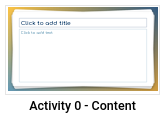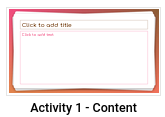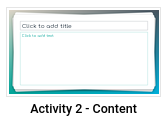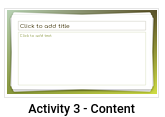Clicking on the topics takes you to the lesson plans. These are listed in the order that they're typically taught. A high-level conceptual organization scheme for these lessons can be found on the concept groupings page. For more on how to shape these into your schedule see the page on designing your schedule.
| 1.1 Introduction and When Is Science Relevant | When is science relevant? The many uses of a scientific approach. | |
| 1.2 Shared Reality and Modeling | Science is grounded in belief in a common, shared reality with some degree of regularity. | |
| 2.1 Senses and Instrumentation | Science uses both our direct senses and a variety of instruments to extend our ability to observe phenomena. We trust our instruments for the same reasons we trust our senses; interactive exploration and comparison. | |
| 2.2 Systematic and Statistical Uncertainty | This topic explores the sources of error and uncertainty in data. | |
| 3.1 Probabilistic Reasoning | Using meta-judgments of the likelihood that your best judgment is right—how confident you are—enables decisions that take uncertainty into account. | |
| 3.2 Calibration of Credence Levels | It is important to check the calibration of credence levels; that is, how good one's judgments are about how likely each of one's claims is to be right. | |
| 4.1 Signal and Noise | The challenges of finding the information we want amidst messy data. | |
| 4.2 Finding Patterns in Random Noise | We often find mistake noise for signal; how do we minimize these mistakes, given that they are not always easy to tell apart? | |
| 5.1 False Positives and Negatives | Considering the relative costs of each possible mistake helps us make better decisions under conditions of uncertainty, when we cannot eliminate the possibility of a mistake either way. | |
| 5.2 Scientific Optimism | The psychological trick of believing one will make progress long enough to enable solving difficult problems. | |
| 6.1 Correlation and Causation | An introduction to the scientific approach to determining causal relationships. | |
| 6.2 Hill's Criteria | Building on Correlation and Causation, we examine how to collect evidence for causality in more difficult cases. | |
| 7.1 Causation, Blame, and Policy | Distinguishing singular causation ([math]\displaystyle{ A }[/math] caused [math]\displaystyle{ B }[/math]) from general causation ([math]\displaystyle{ X }[/math] tends to cause [math]\displaystyle{ Y }[/math]). | |
| 7.2 Emergent Phenomena | Many phenomena in science are emergent, i.e., visible only at higher levels of organization. This tends to occur when large numbers of elements interact, e.g. as in individuals on social media. | |
| 8.1 Orders of Understanding | Because each event and/or phenomenon has many causal factors, it is often important to distinguish which factors affect it the most and which factors play a smaller role. | |
| 8.2 Fermi Problems | Estimating quantities based on what we know. | |
| 9.1 Heuristics | Some of the heuristics biases that make our probability judgments go awry. | |
| 9.2 Biases | Some of the psychological biases that make our probability judgments go awry. | |
| 10.1 Confirmation Bias | Our tendency to preserve our existing or preferred beliefs, even against the evidence. | |
| 10.2 Blinding | Blind analysis, the practice of deciding how we will analyze data before finding out if the analysis we have chosen supports our hypothesis, counteracts confirmation bias. | |
| 11.1 Pathological Science | How to catch bad science. | |
| 11.2 When Is Science Suspect | The capacity for science to be misused to reinforce existing power structures. | |
| 12.1 Wisdom of Crowds and Herd Thinking | Explore ways that groups fall short of their optimal reasoning ability. There are better and worse ways to aggregate a group's knowledge. | |
| 12.2 Grill the Guest | Confront a working scientist about their work using course concepts. | |
| 13.1 Denver Bullet Study | The Denver Bullet Study offers one approach to integrating facts and values in a controversial real-world problem, drawing facts from a set of experts, gauging the values of different stakeholders, and bringing these together for a final decision. | |
| 13.2 Deliberative Polling | Another approach to getting groups of people to come together to make decisions, in a process where the integration of facts and values is scaffolded. | |
| 14.1 Scenario Planning | A third approach to integrating facts and values under conditions of uncertainty about what the future will be like. | |
| 14.2 Wrap Up | An overview and conclusion of the course. |
How to Read a Lesson Plan
There are five parts to each lesson plan.
The Lesson in Context
Each lesson plan begins with a short summary of how it fits into the bigger picture of the course. The summary is followed by expandable sections detailing its relation to earlier and later lessons.
Takeaways
This part of the lesson plan lists target learning goals for the students, definitions that are used in both the lecture and discussion section, examples demonstrating the topic at hand, and several misconceptions that the lesson is designed to address.
Note that these misconceptions are not necessarily ones that students are left with after the lesson. Rather, these are the misconceptions that the lesson is designed in response to in the first place.
Useful Resources
Every lesson plan has an embedded example lecture video, a set of slides that can be used for the discussion section, readings and assignments to give students for homework prior to lesson, and a "handouts and activities" section. This last item has links to any worksheets or other material that's relevant for the discussion section's activities.
Recommended Outline
This section gives an overall schedule for each discussion section as well as any steps that need to be taken before or after each class. This section may note resources you need to gather for each lesson. You can see a full list of these on the inventory page.
Lesson Content
The last section of each lesson has detailed instructions for how to implement the discussion section. This includes minute-by-minute timings, instructions for each activity, answers to each discussion question, and much more. A useful key for reading this is included below.
Answer
Boxes of this color note the answer to some question. In the case of multiple choice questions, the correct answer may instead be highlighted in a small green box.
Tip
Anything in a box of this color is some useful tip that may help with implementing the lesson.
Caution
Boxes of this color provide notes of cation or things to watch out for while teaching the lesson.
Warning
These boxes give you high-level warnings about important implementation details that significantly affect how you plan and run the lesson.
How to Read Discussion Slides
The slides for each labscussion are color coded. The "gold-blue" slides represent the "introduction" slides and typically have content you can quickly brush through.
The remaining slides cycle through "red", "blue", and "green" slides. These always progress in the same order. A change in color corresponds is a visual cue that shows the labscussion is moving on to a new activity. All the slides for the same activity are of the same color. The colors keep cycling if there are more than three activities in a lesson. The section's agenda is also shown whenever there's a transition to a new activity.
Introductions
Every slide deck begins with a title card that introduces the lesson. Followed by the lesson's agenda, learning goals, and definitions. Note that the lessons are (typically) not designed to have much time for review at the start. So, you don't have to spend time going over the learning goals and definitions in each section. They're mainly included so that you can flip back to them during class if it comes up and so that the students can reference them easily after class.



